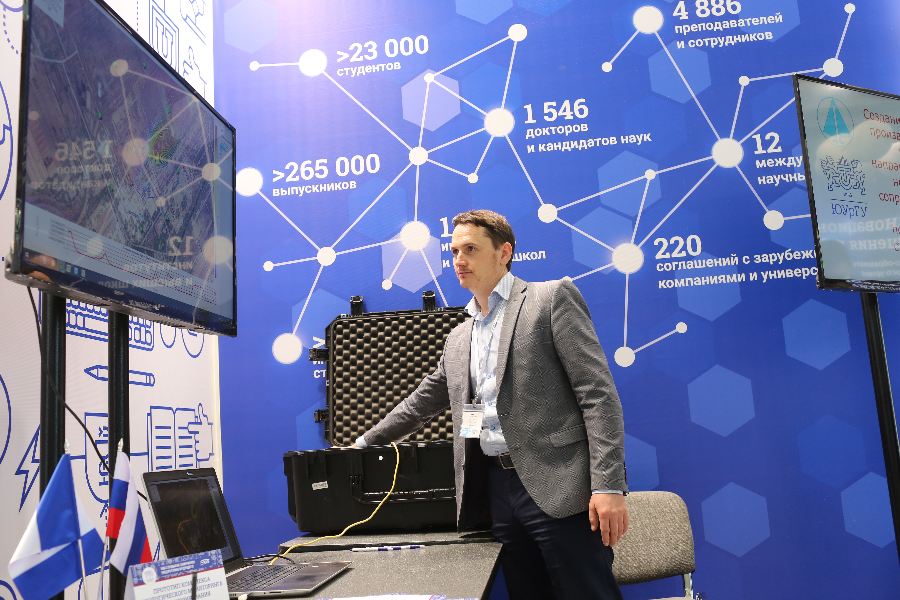On December 10th-11th, South Ural State University took part in the Annual National Exhibition "VUZPROMEXPO-2020" in Moscow.
The Annual National Exhibition contributes to the development and popularization of science, and designates new career prospects for young scientists. This year, the key topic was the development of a new national project "Science and Universities", which marks a new approach and new criteria for assessing the quality of higher education and the development of science in our country. The results of interaction with industrial partners and contribution to the economy are becoming one of the key indicators of the university's performance, along with scientific articles and top positions in international rankings.
"The VUZPROMEXPO-2020 Exhibition is one of the best platforms for demonstrating the scientific achievements and developments of the university for the year. At such events, our scientists participate in panel sessions, learn new trends and directions in the scientific agenda of the Russian Federation, exchange experience with representatives of leading universities, research and education centres, state corporations and industrial enterprises. Participation in the exhibition helps find new partners and build consortia, which are the basis of the forthcoming Program of Strategic Academic Leadership. At VUZPROMEXPO, the university presented a number of exhibits developed jointly with its industrial partners in three fields: Digital Industry, Materials Science, and Ecology. It should be noted that almost all the presented developments included the use of artificial intelligence methods," noted the Vice-Rector for Research, Doctor of Sciences (Engineering) Anton Korzhov.
SUSU jointly with its industrial partner OOO PK Khodovye Sistemy demonstrated the result of their work on the project of creating a high-tech production of a stepless differential swing mechanism with a tracking control system for off-road and road-building machines of the new generation. The project is being implemented under the Government Decree No. 218 with financial support from the Ministry of Science and Higher Education of the Russian Federation.
At the exhibition, within the framework of a joint project (Government Decree No. 218) with the Ural Engineering Centre, Doctor of Sciences (Engineering), Professor of the Department of Automation Engineering Dmitrii Ardashev presented a new hydraulic drive designed to provide multi-cycle loads on the test object. It can be used in mechanical engineering, aircraft construction, and resource industries.
"This development has no analogues in our country. A specific feature of the new hydraulic drive is that it has hydrostatic guides in its design, which provide a large number of loading cycles (up to 100 million), as well as the resistance of the drive to external force effects that can lead to the failure of the entire unit. In addition, the chrome coating of the outer surface of the hydraulic cylinder barrel allows ensuring a long service life of such hydraulic drives and the required frequency response characteristics," explains Dmitrii Ardashev.
The university presented two projects implemented under the Federal Targeted Programme for Research and Development in Priority Areas of Development of the Russian Scientific and Technological Complex for 2014-2021:
Jointly with industrial partners, a set of technological solutions have been created for obtaining new metallic materials, from which containers for storing radiation waste are made, with the improvement of the method of their vitrification. The metallic materials obtained by the proposed technologies have increased indicators of physical and mechanical properties in comparison with the materials used at present; the technical and economic assessment indicates at a decrease in the cost of production of materials using the proposed technology.
A designed and tested by SUSU scientists sample of an integrated self-adjusting control system for a complicated technological complex of production and for transmission and consumption of heat energy and water was presented at the exhibition. Experimental samples of autonomous intelligent pressure and temperature sensors, intelligent thermostats with a built-in room temperature sensor, autonomous intelligent residential water meters with a function of limiting water consumption were designed specially for this system.
The SUSU Computer Engineering Centre presented the results of the latest developments in transport engineering. Among its major gains for 2020 is the results of a successful project with AO Kurgandormash on the development of a large-class vacuum floor sweeper. The Centre employees took part in the panel discussion on the topic of "Engineering Is a Link between Science, Education and Industry". On the second day of the exhibition, new programmes for training and retraining of personnel in the field of digital technologies were announced.
The Ecomonitor project on environmental monitoring and forecasting, which is being implemented jointly with Emerson Corporation, was also presented at the exhibition. The university demonstrated a hardware and software prototype of the Ecomonitor complex, which has a modular architecture and allows to determine the concentration of pollutants in the ambient air in real time anywhere in the city, conduct automated analysis of the emissions data, and make data visualization in a georeferenced map.
The project on the intelligent traffic monitoring system called Artificial Intelligence Monitoring System (AIMS) sparked the interest of the scientific community as well. The goal of the project is to develop and implement a system for assessing the effectiveness of the use of traffic infrastructure, predicting road traffic congestion and total toxic emissions from vehicles. The use of deep learning neural networks allows for real-time collection, interpretation and aggregation of data on the intensity and classification of road traffic. At the exhibition, the university presented an intelligent system for monitoring specific emissions of pollutants from road traffic flows based on the use of convolution neural networks.
We should also specifically mention the project on the creation of a biodegradable material for packaging food products and disposable tableware, which combined two priority scientific fields for our university: Materials Science and Ecology.
All the exhibits presented at VUZPROMEXPO were highly appreciated by the academic community and representatives of the industrial sector.





.JPG)
